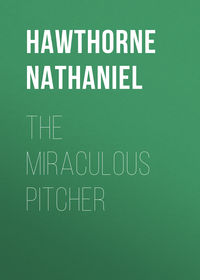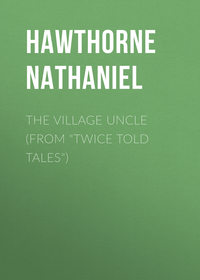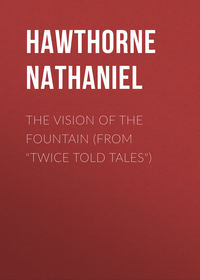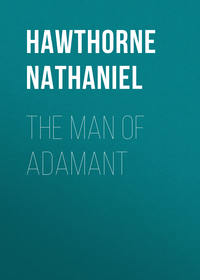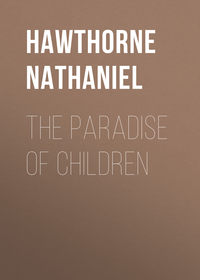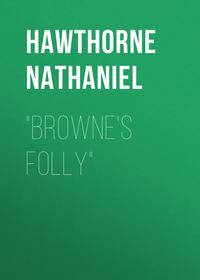 полная версия
полная версияPassages from the French and Italian Notebooks, Complete
February 14th. – Friday, 12th, was a sunny day, the first that we had had for some time; and my wife and I went forth to see sights as well as to make some calls that had long been due. We went first to the church of Santa Maria Maggiore, which I have already mentioned, and, on our return, we went to the Piazza di Monte Cavallo, and saw those admirable ancient statues of Castor and Pollux, which seem to me sons of the morning, and full of life and strength. The atmosphere, in such a length of time, has covered the marble surface of these statues with a gray rust, that envelops both the men and horses as with a garment; besides which, there are strange discolorations, such as patches of white moss on the elbows, and reddish streaks down the sides; but the glory of form overcomes all these defects of color. It is pleasant to observe how familiar some little birds are with these colossal statues, – hopping about on their heads and over their huge fists, and very likely they have nests in their ears or among their hair.
We called at the Barberini Palace, where William Story has established himself and family for the next seven years, or more, on the third piano, in apartments that afford a very fine outlook over Rome, and have the sun in them through most of the day. Mrs. S – invited us to her fancy ball, but we declined.
On the staircase ascending to their piano we saw the ancient Greek bas-relief of a lion, whence Canova is supposed to have taken the idea of his lions on the monument in St. Peter's. Afterwards we made two or three calls in the neighborhood of the Piazza de' Spagna, finding only Mr. Hamilton Fish and family, at the Hotel d'Europe, at home, and next visited the studio of Mr. C. G. Thompson, whom I knew in Boston. He has very greatly improved since those days, and, being always a man of delicate mind, and earnestly desiring excellence for its own sake, he has won himself the power of doing beautiful and elevated works. He is now meditating a series of pictures from Shakespeare's "Tempest," the sketches of one or two of which he showed us, likewise a copy of a small Madonna, by Raphael, wrought with a minute faithfulness which it makes one a better man to observe… Mr. Thompson is a true artist, and whatever his pictures have of beauty comes from very far beneath the surface; and this, I suppose, is one weighty reason why he has but moderate success. I should like his pictures for the mere color, even if they represented nothing. His studio is in the Via Sistina; and at a little distance on the other side of the same street is William Story's, where we likewise went, and found him at work on a sitting statue of Cleopatra.
William Story looks quite as vivid, in a graver way, as when I saw him last, a very young man. His perplexing variety of talents and accomplishments – he being a poet, a prose writer, a lawyer, a painter, a musician, and a sculptor – seems now to be concentrating itself into this latter vocation, and I cannot see why he should not achieve something very good. He has a beautiful statue, already finished, of Goethe's Margaret, pulling a flower to pieces to discover whether Faust loves her; a very type of virginity and simplicity. The statue of Cleopatra, now only fourteen days advanced in the clay, is as wide a step from the little maidenly Margaret as any artist could take; it is a grand subject, and he is conceiving it with depth and power, and working it out with adequate skill. He certainly is sensible of something deeper in his art than merely to make beautiful nudities and baptize them by classic names. By the by, he told me several queer stories of American visitors to his studio: one of them, after long inspecting Cleopatra, into which he has put all possible characteristics of her time and nation and of her own individuality, asked, "Have you baptized your statue yet?" as if the sculptor were waiting till his statue were finished before he chose the subject of it, – as, indeed, I should think many sculptors do. Another remarked of a statue of Hero, who is seeking Leander by torchlight, and in momentary expectation of finding his drowned body, "Is not the face a little sad?" Another time a whole party of Americans filed into his studio, and ranged themselves round his father's statue, and, after much silent examination, the spokesman of the party inquired, "Well, sir, what is this intended to represent?" William Story, in telling these little anecdotes, gave the Yankee twang to perfection…
The statue of his father, his first work, is very noble, as noble and fine a portrait-statue as I ever saw. In the outer room of his studio a stone-cutter, or whatever this kind of artisan is called, was at work, transferring the statue of Hero from the plaster-cast into marble; and already, though still in some respects a block of stone, there was a wonderful degree of expression in the face. It is not quite pleasant to think that the sculptor does not really do the whole labor on his statues, but that they are all but finished to his hand by merely mechanical people. It is generally only the finishing touches that are given by his own chisel.
Yesterday, being another bright day, we went to the basilica of St. John Lateran, which is the basilica next in rank to St. Peter's, and has the precedence of it as regards certain sacred privileges. It stands on a most noble site, on the outskirts of the city, commanding a view of the Sabine and Alban hills, blue in the distance, and some of them hoary with sunny snow. The ruins of the Claudian aqueduct are close at hand. The church is connected with the Lateran palace and museum, so that the whole is one edifice; but the facade of the church distinguishes it, and is very lofty and grand, – more so, it seems to me, than that of St. Peter's. Under the portico is an old statue of Constantine, representing him as a very stout and sturdy personage. The inside of the church disappointed me, though no doubt I should have been wonderstruck had I seen it a month ago. We went into one of the chapels, which was very rich in colored marbles; and, going down a winding staircase, found ourselves among the tombs and sarcophagi of the Corsini family, and in presence of a marble Pieta very beautifully sculptured. On the other side of the church we looked into the Torlonia Chapel, very rich and rather profusely gilded, but, as it seemed to me, not tawdry, though the white newness of the marble is not perfectly agreeable after being accustomed to the milder tint which time bestows on sculpture. The tombs and statues appeared like shapes and images of new-fallen snow. The most interesting thing which we saw in this church (and, admitting its authenticity, there can scarcely be a more interesting one anywhere) was the table at which the Last Supper was eaten. It is preserved in a corridor, on one side of the tribune or chancel, and is shown by torchlight suspended upon the wall beneath a covering of glass. Only the top of the table is shown, presenting a broad, flat surface of wood, evidently very old, and showing traces of dry-rot in one or two places. There are nails in it, and the attendant said that it had formerly been covered with bronze. As well as I can remember, it may be five or six feet square, and I suppose would accommodate twelve persons, though not if they reclined in the Roman fashion, nor if they sat as they do in Leonardo da Vinci's picture. It would be very delightful to believe in this table.
There are several other sacred relics preserved in the church; for instance, the staircase of Pilate's house up which Jesus went, and the porphyry slab on which the soldiers cast lots for his garments. These, however, we did not see. There are very glowing frescos on portions of the walls; but, there being much whitewash instead of incrusted marble, it has not the pleasant aspect which one's eye learns to demand in Roman churches. There is a good deal of statuary along the columns of the nave, and in the monuments of the side aisles.
In reference to the interior splendor of Roman churches, I must say that I think it a pity that painted windows are exclusively a Gothic ornament; for the elaborate ornamentation of these interiors puts the ordinary daylight out of countenance, so that a window with only the white sunshine coming through it, or even with a glimpse of the blue Italian sky, looks like a portion left unfinished, and therefore a blotch in the rich wall. It is like the one spot in Aladdin's palace which he left for the king, his father-in-law, to finish, after his fairy architects had exhausted their magnificence on the rest; and the sun, like the king, fails in the effort. It has what is called a porta santa, which we saw walled up, in front of the church, one side of the main entrance. I know not what gives it its sanctity, but it appears to be opened by the pope on a year of jubilee, once every quarter of a century.
After our return… I took R – along the Pincian Hill, and finally, after witnessing what of the Carnival could be seen in the Piazza del Popolo from that safe height, we went down into the Corso, and some little distance along it. Except for the sunshine, the scene was much the same as I have already described; perhaps fewer confetti and more bouquets. Some Americans and English are said to have been brought before the police authorities, and fined for throwing lime. It is remarkable that the jollity, such as it is, of the Carnival, does not extend an inch beyond the line of the Corso; there it flows along in a narrow stream, while in the nearest street we see nothing but the ordinary Roman gravity.
February 15th. – Yesterday was a bright day, but I did not go out till the afternoon, when I took an hour's walk along the Pincian, stopping a good while to look at the old beggar who, for many years past, has occupied one of the platforms of the flight of steps leading from the Piazza de' Spagna to the Triniti de' Monti. Hillard commemorates him in his book. He is an unlovely object, moving about on his hands and knees, principally by aid of his hands, which are fortified with a sort of wooden shoes; while his poor, wasted lower shanks stick up in the air behind him, loosely vibrating as he progresses. He is gray, old, ragged, a pitiable sight, but seems very active in his own fashion, and bestirs himself on the approach of his visitors with the alacrity of a spider when a fly touches the remote circumference of his web. While I looked down at him he received alms from three persons, one of whom was a young woman of the lower orders; the other two were gentlemen, probably either English or American. I could not quite make out the principle on which he let some people pass without molestation, while he shuffled from one end of the platform to the other to intercept an occasional individual. He is not persistent in his demands, nor, indeed, is this a usual fault among Italian beggars. A shake of the head will stop him when wriggling towards you from a distance. I fancy he reaps a pretty fair harvest, and no doubt leads as contented and as interesting a life as most people, sitting there all day on those sunny steps, looking at the world, and making his profit out of it. It must be pretty much such an occupation as fishing, in its effect upon the hopes and apprehensions; and probably he suffers no more from the many refusals he meets with than the angler does, when he sees a fish smell at his bait and swim away. One success pays for a hundred disappointments, and the game is all the better for not being entirely in his own favor.
Walking onward, I found the Pincian thronged with promenaders, as also with carriages, which drove round the verge of the gardens in an unbroken ring.
To-day has been very rainy. I went out in the forenoon, and took a sitting for my bust in one of a suite of rooms formerly occupied by Canova. It was large, high, and dreary from the want of a carpet, furniture, or anything but clay and plaster. A sculptor's studio has not the picturesque charm of that of a painter, where there is color, warmth, and cheerfulness, and where the artist continually turns towards you the glow of some picture, which is resting against the wall… I was asked not to look at the bust at the close of the sitting, and, of course, I obeyed; though I have a vague idea of a heavy-browed physiognomy, something like what I have seen in the glass, but looking strangely in that guise of clay…
It is a singular fascination that Rome exercises upon artists. There is clay elsewhere, and marble enough, and heads to model, and ideas may be made sensible objects at home as well as here. I think it is the peculiar mode of life that attracts, and its freedom from the inthralments of society, more than the artistic advantages which Rome offers; and, no doubt, though the artists care little about one another's works, yet they keep each other warm by the presence of so many of them.
The Carnival still continues, though I hardly see how it can have withstood such a damper as this rainy day. There were several people – three, I think – killed in the Corso on Saturday; some accounts say that they were run over by the horses in the race; others, that they were ridden down by the dragoons in clearing the course.
After leaving Canova's studio, I stepped into the church of San Luigi de' Francesi, in the Via di Ripetta. It was built, I believe, by Catherine de' Medici, and is under the protection of the French government, and a most shamefully dirty place of worship, the beautiful marble columns looking dingy, for the want of loving and pious care. There are many tombs and monuments of French people, both of the past and present, – artists, soldiers, priests, and others, who have died in Rome. It was so dusky within the church that I could hardly distinguish the pictures in the chapels and over the altar, nor did I know that there were any worth looking for. Nevertheless, there were frescos by Domenichino, and oil-paintings by Guido and others. I found it peculiarly touching to read the records, in Latin or French, of persons who had died in this foreign laud, though they were not my own country-people, and though I was even less akin to them than they to Italy. Still, there was a sort of relationship in the fact that neither they nor I belonged here.
February 17th. – Yesterday morning was perfectly sunny, and we went out betimes to see churches; going first to the Capuchins', close by the Piazza Barberini.
["The Marble Faun" takes up this description of the church and of the dead monk, which we really saw, just as recounted, even to the sudden stream of blood which flowed from the nostrils, as we looked at him. – ED.]
We next went to the Trinita de' Monti, which stands at the head of the steps, leading, in several flights, from the Piazza de' Spagna. It is now connected with a convent of French nuns, and when we rang at a side door, one of the sisterhood answered the summons, and admitted us into the church. This, like that of the Capuchins', had a vaulted roof over the nave, and no side aisles, but rows of chapels instead. Unlike the Capuchins', which was filthy, and really disgraceful to behold, this church was most exquisitely neat, as women alone would have thought it worth while to keep it. It is not a very splendid church, not rich in gorgeous marbles, but pleasant to be in, if it were only for the sake of its godly purity. There was only one person in the nave; a young girl, who sat perfectly still, with her face towards the altar, as long as we stayed. Between the nave and the rest of the church there is a high iron railing, and on the other side of it were two kneeling figures in black, so motionless that I at first thought them statues; but they proved to be two nuns at their devotions; and others of the sisterhood came by and by and joined them. Nuns, at least these nuns, who are French, and probably ladies of refinement, having the education of young girls in charge, are far pleasanter objects to see and think about than monks; the odor of sanctity, in the latter, not being an agreeable fragrance. But these holy sisters, with their black crape and white muslin, looked really pure and unspotted from the world.
On the iron railing above mentioned was the representation of a golden heart, pierced with arrows; for these are nuns of the Sacred Heart. In the various chapels there are several paintings in fresco, some by Daniele da Volterra; and one of them, the "Descent from the Cross," has been pronounced the third greatest picture in the world. I never should have had the slightest suspicion that it was a great picture at all, so worn and faded it looks, and so hard, so difficult to be seen, and so undelightful when one does see it.
From the Trinita we went to the Santa Maria del Popolo, a church built on a spot where Nero is said to have been buried, and which was afterwards made horrible by devilish phantoms. It now being past twelve, and all the churches closing from twelve till two, we had not time to pay much attention to the frescos, oil-pictures, and statues, by Raphael and other famous men, which are to be seen here. I remember dimly the magnificent chapel of the Chigi family, and little else, for we stayed but a short time; and went next to the sculptor's studio, where I had another sitting for my bust. After I had been moulded for about an hour, we turned homeward; but my wife concluded to hire a balcony for this last afternoon and evening of the Carnival, and she took possession of it, while I went home to send to her Miss S – and the two elder children. For my part, I took R – , and walked, by way of the Pincian, to the Piazza del Popolo, and thence along the Corso, where, by this time, the warfare of bouquets and confetti raged pretty fiercely. The sky being blue and the sun bright, the scene looked much gayer and brisker than I had before found it; and I can conceive of its being rather agreeable than otherwise, up to the age of twenty. We got several volleys of confetti. R – received a bouquet and a sugar-plum, and I a resounding hit from something that looked more like a cabbage than a flower. Little as I have enjoyed the Carnival, I think I could make quite a brilliant sketch of it, without very widely departing from truth.
February 19th. – Day before yesterday, pretty early, we went to St. Peter's, expecting to see the pope cast ashes on the heads of the cardinals, it being Ash-Wednesday. On arriving, however, we found no more than the usual number of visitants and devotional people scattered through the broad interior of St. Peter's; and thence concluded that the ceremonies were to be performed in the Sistine Chapel. Accordingly, we went out of the cathedral, through the door in the left transept, and passed round the exterior, and through the vast courts of the Vatican, seeking for the chapel. We had blundered into the carriage-entrance of the palace; there is an entrance from some point near the front of the church, but this we did not find. The papal guards, in the strangest antique and antic costume that was ever seen, – a party-colored dress, striped with blue, red, and yellow, white and black, with a doublet and ruff, and trunk-breeches, and armed with halberds, – were on duty at the gateways, but suffered us to pass without question. Finally, we reached a large court, where some cardinals' red equipages and other carriages were drawn up, but were still at a loss as to the whereabouts of the chapel. At last an attendant kindly showed us the proper door, and led us up flights of stairs, along passages and galleries, and through halls, till at last we came to a spacious and lofty apartment adorned with frescos; this was the Sala Regia, and the antechamber to the Sistine Chapel.
The attendant, meanwhile, had informed us that my wife could not be admitted to the chapel in her bonnet, and that I myself could not enter at all, for lack of a dress-coat; so my wife took off her bonnet, and, covering her head with her black lace veil, was readily let in, while I remained in the Sala Regia, with several other gentlemen, who found themselves in the same predicament as I was. There was a wonderful variety of costume to be seen and studied among the persons around me, comprising garbs that have been elsewhere laid aside for at least three centuries, – the broad, plaited, double ruff, and black velvet cloak, doublet, trunk-breeches, and sword of Queen Elizabeth's time, – the papal guard, in their striped and party-colored dress as before described, looking not a little like harlequins; other soldiers in helmets and jackboots; French officers of various uniform; monks and priests; attendants in old-fashioned and gorgeous livery; gentlemen, some in black dress-coats and pantaloons, others in wide-awake hats and tweed overcoats; and a few ladies in the prescribed costume of black; so that, in any other country, the scene might have been taken for a fancy ball. By and by, the cardinals began to arrive, and added their splendid purple robes and red hats to make the picture still more brilliant. They were old men, one or two very aged and infirm, and generally men of bulk and substance, with heavy faces, fleshy about the chin. Their red hats, trimmed with gold-lace, are a beautiful piece of finery, and are identical in shape with the black, loosely cocked beavers worn by the Catholic ecclesiastics generally. Wolsey's hat, which I saw at the Manchester Exhibition, might have been made on the same block, but apparently was never cocked, as the fashion now is. The attendants changed the upper portions of their master's attire, and put a little cap of scarlet cloth on each of their heads, after which the cardinals, one by one, or two by two, as they happened to arrive, went into the chapel, with a page behind each holding up his purple train. In the mean while, within the chapel, we heard singing and chanting; and whenever the voluminous curtains that hung before the entrance were slightly drawn apart, we outsiders glanced through, but could see only a mass of people, and beyond them still another chapel, divided from the hither one by a screen. When almost everybody had gone in, there was a stir among the guards and attendants, and a door opened, apparently communicating with the inner apartments of the Vatican. Through this door came, not the pope, as I had partly expected, but a bulky old lady in black, with a red face, who bowed towards the spectators with an aspect of dignified complaisance as she passed towards the entrance of the chapel. I took off my hat, unlike certain English gentlemen who stood nearer, and found that I had not done amiss, for it was the Queen of Spain.
There was nothing else to be seen; so I went back through the antechambers (which are noble halls, richly frescoed on the walls and ceilings), endeavoring to get out through the same passages that had let me in. I had already tried to descend what I now supposed to be the Scala Santa, but had been turned back by a sentinel. After wandering to and fro a good while, I at last found myself in a long, long gallery, on each side of which were innumerable inscriptions, in Greek and Latin, on slabs of marble, built into the walls; and classic altars and tablets were ranged along, from end to end. At the extremity was a closed iron grating, from which I was retreating; but a French gentleman accosted me, with the information that the custode would admit me, if I chose, and would accompany me through the sculpture department of the Vatican. I acceded, and thus took my first view of those innumerable art-treasures, passing from one object to another, at an easy pace, pausing hardly a moment anywhere, and dismissing even the Apollo, and the Laocoon, and the Torso of Hercules, in the space of half a dozen breaths. I was well enough content to do so, in order to get a general idea of the contents of the galleries, before settling down upon individual objects.
Most of the world-famous sculptures presented themselves to my eye with a kind of familiarity, through the copies and casts which I had seen; but I found the originals more different than I anticipated. The Apollo, for instance, has a face which I have never seen in any cast or copy. I must confess, however, taking such transient glimpses as I did, I was more impressed with the extent of the Vatican, and the beautiful order in which it is kept, and its great sunny, open courts, with fountains, grass, and shrubs, and the views of Rome and the Campagna from its windows, – more impressed with these, and with certain vastly capacious vases, and two seat sarcophagi, – than with the statuary. Thus I went round the whole, and was dismissed through the grated barrier into the gallery of inscriptions again; and after a little more wandering, I made my way out of the palace…


